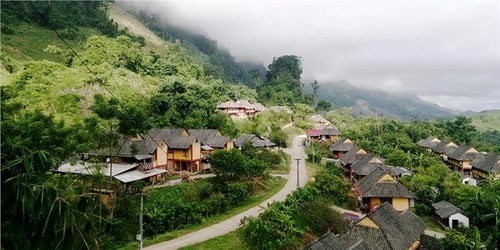|
Located in a wide valley 170
km from
Dien Bien Phu and 115 km from
Moc Chau,
near the border of Laos,
Son La is the capital
of an important town lies on the territory of
the former French colonial province
 The territory of the province is 80% occupied by
forests and mountains, Moc Chau and Na San are
two broad plateaus at 600 m altitude, which are
famous centres of tea and dairy cattle. The long
rivers Da and Ma run crossing the province, the
province has many large meadows are favorable
for cattle and horses. Forests provide many
kinds of precious wood such as Rosewood, stick-lac…
There are mines of tin, copper and zinc. The
town offers travelers en route to Dien Bien Phu
the opportunity to stop for a night, the area is
populated by many ethnic groups of Vietnam such
as Viet, Thai, H'mong, Dao, Muong… The central
market of Thai black, and the former prison
built by the French in the French colonial era
is one very interesting site to visit. The territory of the province is 80% occupied by
forests and mountains, Moc Chau and Na San are
two broad plateaus at 600 m altitude, which are
famous centres of tea and dairy cattle. The long
rivers Da and Ma run crossing the province, the
province has many large meadows are favorable
for cattle and horses. Forests provide many
kinds of precious wood such as Rosewood, stick-lac…
There are mines of tin, copper and zinc. The
town offers travelers en route to Dien Bien Phu
the opportunity to stop for a night, the area is
populated by many ethnic groups of Vietnam such
as Viet, Thai, H'mong, Dao, Muong… The central
market of Thai black, and the former prison
built by the French in the French colonial era
is one very interesting site to visit.
Son La is the homeland of the flowers, primitive
forest and mountain winding roads coupled with
the natural landscape to create poetic sceneries
about the great possibilities for sightseeing
and photography. This region is located on a
plateau above 1000m altitude above sea level,
the average summer temperature is 20 degrees
Celsius. Travellers can take boat trips on the
Da River Lake by canoe, motor boat or sampan
beholding the charming views of the scene of
ethnic minorities along the river... with their
colourful culture and rich ethnic festivals,
habits…. This is where travelers find the
landscape "Tham Tat Tong" a beautiful miracle of
the Creator - a 150m long limestone cave, the
stone columns crammed nestled along two the
vertical cave walls as the tree structure.
Coming to the area visitors cannot miss the hot
springs, making you so relaxed in winter and
summer as well.
The former penitentiary Son La
The site of Son La prison, founded by the
French, welcomed in its jails Vietnamese
anticolonial. The former French prison was
partially restored for history buffs. Turrets
and towers are rebuilt to monitor the remains of
cells and inner walls. A peach tree planted by
To Hieu, one of the first inmates of the 40s, is
the only survivor of the bombing. Today, a
street, a school and some important buildings of
Son La took the name of To Hieu. Prison is a
place steeped in history, has not ended with the
departure of the French. Different Montagnards
who fought alongside the colonists in the war
between France and the Viet Minh. Many
Montagnards still wear the beret of the French!
Along the main road, a large brown sign
decorated with chains, marks the beginning of
path that climbs to the site and leads to the
local People's Committee, behind which stands
the prison.
|
 Travel Blog
Travel Blog